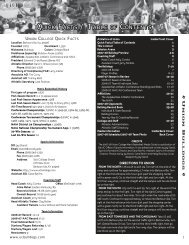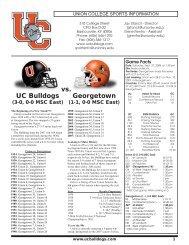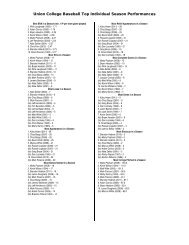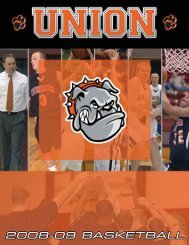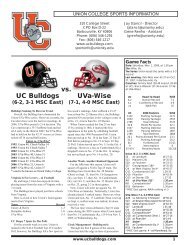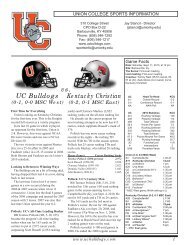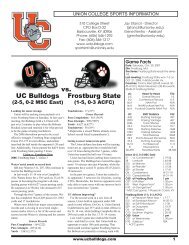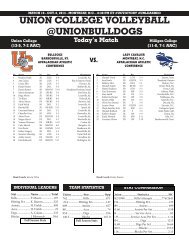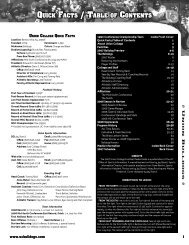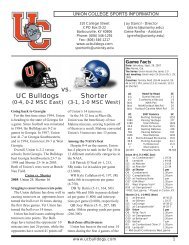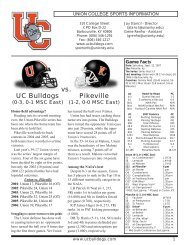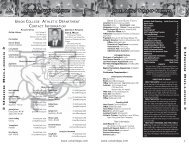Union College Athletics
Union College Athletics
Union College Athletics
- No tags were found...
You also want an ePaper? Increase the reach of your titles
YUMPU automatically turns print PDFs into web optimized ePapers that Google loves.
The National Association of Intercollegiate <strong>Athletics</strong>BULLDOG BASEBALLIn searching for the NAIA’s placein the history of sports and highereducation, several consistenciesare revealed. Among them is thededication to academic achievementabove athletic excellence. Alsoapparent is the organization’s roleas a trailblazer in providing equalopportunities for all student-athletes.Above all, there is an expectation ofethical behavior and a commitmentto scholarship, sportsmanship andleadership.It is paradoxical that such a lasting,dynamic contribution to collegiatesports began with a mundane notein the first recorded history of theAssociation: “The first general sessionof the ‘Organizing Convention’of the National Association ofIntercollegiate Basketball (NAIB)was held in the Phillips Hotel, KansasCity, Missouri, at 10 a.m., Sunday,March 10, 1940.”But the seed from which the NAIB sproutedwas planted two blocks away at MunicipalAuditorium. It was there in 1937 that a men’sbasketball tournament tipped off which hasbecome the longest continuous nationalcollegiate tournament in any sport. Further, outof that small-college basketball tournament,and the NAIB, grew an Association thatnow includes more than 360 colleges anduniversi ties and conducts two dozen nationalchampionship events.The tournament was the brainchild of EmilS. Liston, Dr. James Naismith, Frank Cramer,and a group of Kansas City business leaderswho wanted to provide Kansas City-area fanswith exciting amateur competition and toprovide a framework for small colleges anduniversities to determine a national basketballchampion.The original eight-team tournament expandedto 32 teams in 1938 and suspended play onlyfor World War II in 1944 before 16 teamswere invited the following year and the fieldgot back to full strength by 1946. Qualifyingtournaments became mandatory at the districtlevel in 1951.In 1948, the NAIB affirmed its commitmentto equality by becoming the first nationalorganization to offer intercollegiate postseasonopportunities to black student-athletes.Unprecedented action was taken in 1953 whenhistorically black institutions were voted intomembership.One year previous to the inclusion ofhistorically black institutions, another form ofTHE NAIA: A PROUD PAST, A DYNAMIC FUTUREexpansion occurred. In 1952, as a result of theexpressed desires of the member institutions,appropriate steps were taken by which theNAIB was transformed into the NationalAssociation of Intercollegiate <strong>Athletics</strong>(NAIA), and the first all-encompassing set ofrules and standards was adopted.With the Association’s new name came theaddition of national championships in golf,tennis and outdoor track and field. Football,cross country, baseball and swimming anddiving were added to the championshipscalendar in 1956. Wrestling (1958), soccer(1959), bowling (1962-78), gymnastics (1964-84), indoor track and field (1966) and men’svolleyball (1969-80) were added later.Another significant step occurred in 1957when the Association’s headquarters movedfrom the campus of George Pepperdine <strong>College</strong>in Los Angeles to Kansas City to better servethe membership from a centralized location.Two major changes were made during the1970s. An extensive study was completed in1970 which paved the way for two divisionsof football. In 1997, football was consolidatedto one division again as the Football CoachesAssociation cited a narrowing gap betweenenrollment size and philosophy of the twodivisions. In 1976, the men’s basketballtournament was moved from the confines ofthe Municipal Auditorium to Crosby KemperArena, also in Kansas City, marking the firsttime since 1937 that the tournament had beenheld in a different arena.The NAIA revolutionized national collegiateathletics with the establishment ofathletics programs for women onAugust 1, 1980. Official noticeon that date followed a mail voteby the membership on May 1that supported becoming the firstorganization to offer collegiateathletics to both men and women.Championships for women beganthat year with basketball, crosscountry, gymnastics, indoor andoutdoor track and field, softball,tennis and volleyball. Soccerwas added in 1984, and golf wasincluded in 1995.Another important chapter inthe history of the NAIA unfoldedin 1992 when the Associationvoted to move its headquartersfrom Kansas City to Tulsa. OnAugust 1, 1993, the NAIA openedits doors in Tulsa and began a newera. Moving with the nationaloffice was the Division I Men’sBasketball National Championship which hadbeen held in Kansas City for 56 years.During the 1993 NAIA National Conventionin Atlanta, the waves of change once againwashed over the Association. The membershipvoted to institute affiliated conference andregional groupings and discontinue the useof district play as a means of qualification fornational championships.Since 1937, the NAIA has administeredprograms and championships in proper balancewith the overall educational experience. In2000, the NAIA reaffirmed its purpose toenhance the character-building aspects ofsport. Through Champions of Character,the NAIA seeks to create an environment inwhich every student-athlete, coach, officialand spectator is committed to the true spiritof competition through five tenets: respect,integrity, responsibility, servant leadership andsportsmanship.Everything has come full circle. The NAIArelocated its National Office in July of 2001to Olathe, Kansas, just miles from Gardnerwhere the idea for the small-college basketballtournament gave rise to the NAIA. Now,nearly 65 years after that initial tournament,the NAIA Division I Men’s BasketballNational Championship returned to MunicipalAuditorium, the arena that was home to somany memories from 1937-74.In July of 2007, the National Office movedonce again, but not too far from Olathe. TheNAIA relocated its headquarters to downtownKansas City, Mo., as it returned to its roots.20 • <strong>Union</strong> <strong>College</strong>



